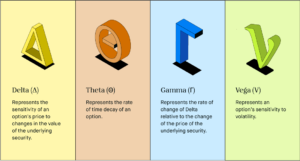Option trading is a form of derivative trading in the stock market where investors can buy or sell options contracts.
Option trading provides investors with the opportunity to speculate on price movements, hedge existing positions, and generate income. However, options trading involves a higher level of complexity and risk compared to traditional stock trading. It’s important for individuals to understand the mechanics of options, including factors like time decay and implied volatility, before engaging in option trading.
What is an Option?
An option is a financial instrument that gives the buyer the right, but not the obligation, to buy or sell an underlying asset at a predetermined price (strike price) within a specified period of time.
There are two types of options: call options and put options.
- Call Option:
- Buyer (Holder): The buyer of a call option pays a premium to acquire the right to buy the underlying asset at the agreed-upon strike price before or at the expiration date.
- Seller (Writer): The seller of a call option receives the premium but takes on the obligation to sell the underlying asset if the buyer decides to exercise the option.
- Put Option:
- Buyer (Holder): The buyer of a put option pays a premium to acquire the right to sell the underlying asset at the agreed-upon strike price before or at the expiration date.
- Seller (Writer): The seller of a put option receives the premium but takes on the obligation to buy the underlying asset if the buyer decides to exercise the option.
Related Article: What are the 3 golden rules of technical analysis?
Key Terms Associated with Option Trading
Strike Price
The strike price, also known as the exercise price, is a crucial element of an options contract. It is the pre-determined price at which the underlying asset (such as stocks, commodities, or indices) can be bought or sold, depending on the type of option. The strike price is agreed upon when the option contract is created. For call options, the buyer has the right to buy the underlying asset at the strike price, while for put options, the buyer has the right to sell the underlying asset at the strike price.
Example:
- If you buy a call option with a strike price of $50 on a certain stock, it means you have the right to buy that stock at $50, regardless of its current market price when the option is exercised.
- If you buy a put option with a strike price of $50 on the same stock, it means you have the right to sell that stock at $50, regardless of its market price when the option is exercised.
Expiration Date
Every options contract has a specified expiration date, which is the date when the option contract becomes invalid. After this date, the option can no longer be exercised, and it loses its value. The expiration date is agreed upon when the option is created, and it can range from days to months, depending on the type of option.
Example:
- If you hold a call option with an expiration date of January 1, 2024, you must exercise the option (if you choose to do so) on or before that date. After January 1, 2024, the option becomes worthless.
- Similarly, if you hold a put option with the same expiration date, you must exercise the option (if you choose to do so) on or before January 1, 2024.
Premium
The premium is the price paid by the option buyer to the option seller (or writer). It represents the cost of buying the option. The premium is influenced by various factors, including the current market price of the underlying asset, the strike price, the time remaining until expiration, and market volatility. The premium is the maximum potential loss for the option buyer and the maximum potential profit for the option seller.
Example:
- If you buy a call option for a premium of $3, you pay $300 (assuming one option contract represents 100 shares). This $300 is the cost of acquiring the right to buy the underlying asset at the agreed-upon strike price.
- The seller of the call option receives this $300 premium but takes on the obligation to sell the underlying asset at the strike price if the buyer decides to exercise the option.
In-the-Money (ITM)
For a call option, it means the market price of the underlying asset is higher than the strike price. For a put option, it means the market price is lower than the strike price. In both cases, there is intrinsic value.
Example: Suppose you have a call option with a strike price of $50, and the current market price of the underlying stock is $60. In this case, the call option is in-the-money because you have the right to buy the stock at $50 (strike price), which is cheaper than the current market price of $60. The $10 difference represents the intrinsic value of the option.
Out-of-the-Money (OTM)
For a call option, it means the market price of the underlying asset is lower than the strike price. For a put option, it means the market price is higher than the strike price. These options typically have no intrinsic value.
Example: Consider a call option with a strike price of $50, but the current market price of the stock is $40. In this case, the call option is out-of-the-money because you wouldn’t want to exercise the option to buy the stock at $50 when you can buy it for $40 in the open market. The option has no intrinsic value in this scenario.
At-the-Money (ATM)
The situation where the market price of the underlying asset is equal to the strike price.
Example: If you have a call option with a strike price of $50, and the current market price of the stock is also $50, the option is considered at-the-money. Similarly, for a put option, if the strike price is $50 and the market price is $50, it’s also at-the-money.
Intrinsic Value
The value of an option if it were exercised immediately. For in-the-money options, the intrinsic value is positive; for at-the-money and out-of-the-money options, the intrinsic value is zero.
Example: If you have a put option with a strike price of $60, and the current market price of the stock is $55, the put option is in-the-money. The intrinsic value is $60 (strike price) – $55 (market price) = $5.
Time Value
The portion of an option’s premium that is attributed to the time remaining until expiration. As the expiration date approaches, the time value tends to decrease.
Example: If a call option has a premium of $8 and $3 of that premium is attributed to intrinsic value, the remaining $5 is the time value. As the option approaches its expiration date, the time value is likely to decrease.
Implied Volatility (IV)
A measure of the market’s expectation of future price volatility of the underlying asset. Higher implied volatility generally leads to higher option premiums.
Example: If the implied volatility of a stock increases due to an upcoming earnings announcement, the premiums for both call and put options on that stock are likely to rise.
Delta
A measure of how much the option price is expected to change for a one-point change in the price of the underlying asset.
Example: If a call option has a delta of 0.7, it means that for every $1 increase in the underlying stock’s price, the call option’s price is expected to increase by $0.70.
Gamma
The rate of change of an option’s delta concerning a one-point change in the price of the underlying asset.
Example: If a call option has a gamma of 0.05, it means that for every $1 increase in the underlying stock’s price, the option’s delta is expected to increase by 0.05.
Theta
A measure of how much the option price is expected to decrease with the passage of one day, all else being equal.
Example: If a call option has a theta of -0.03, it means that, all else being equal, the option’s price is expected to decrease by $0.03 per day as time passes.
Vega
A measure of how much the option price is expected to change for a one-point change in implied volatility.
Example: If a put option has a vega of 0.04, it means that for every 1% increase in implied volatility, the option’s price is expected to increase by $0.04.

How Option Trading Works
- Opening a Position:
- Option trading begins with investors opening positions by either buying or selling options contracts.
- A call option buyer expects the price of the underlying asset to rise, while a put option buyer expects it to fall.
- Premium Payment:
- The option buyer pays a premium to the option seller. This premium is the cost of acquiring the rights conveyed by the option.
- Expiration and Exercise:
- Options have a finite lifespan. The option buyer can choose to exercise the option before or at the expiration date if it is in their favor.
- Exercising a call option allows the buyer to buy the underlying asset at the strike price.
- Exercising a put option allows the buyer to sell the underlying asset at the strike price.
- Profit and Loss:
- The profit or loss for an option position depends on the difference between the current market price of the underlying asset and the strike price, as well as the premium paid or received.
- For option buyers, the potential loss is limited to the premium paid, but the potential profit is theoretically unlimited.
- For option sellers, the potential profit is limited to the premium received, but the potential loss can be unlimited, especially in the case of naked positions.
- Closing the Position:
- Investors can close their option positions before expiration by entering an offsetting trade. This could involve selling a bought option or buying back a sold option.
- Closing a position allows investors to realize gains or losses and avoid the exercise or assignment of the option.
Related Article: How to Read and Analyze Stock Charts
Benefits and Risks of Option Trading
Option trading can offer several benefits, but it also comes with its own set of risks. Understanding both the advantages and disadvantages is crucial for anyone considering engaging in option trading.

Benefits of Option Trading
- Leverage: Options allow investors to control a large position with a relatively small amount of capital. This leverage can amplify both gains and losses.
- Flexibility: Options provide a variety of strategies that can be tailored to different market conditions and investor objectives, including speculation, income generation, and risk management.
- Hedging: Options can be used as a hedging tool to protect an existing position from adverse price movements. This can help manage risk in a portfolio.
- Income Generation: Certain option strategies, such as covered calls, can generate income through the collection of premiums.
- Limited Risk for Buyers: For option buyers, the risk is limited to the premium paid for the option. This defined risk can be appealing for risk-averse investors.
Risks of Option Trading
- Leverage: While leverage can magnify profits, it also magnifies losses. A small adverse price movement in the underlying asset can result in a significant loss.
- Complexity: Options can be complex financial instruments, and understanding their mechanics and various strategies requires a learning curve. Inexperienced traders may find it challenging to navigate the options market effectively.
- Time Decay: Options have a limited lifespan, and their value is influenced by time decay. As the expiration date approaches, the time value of the option tends to decrease, potentially leading to losses for option buyers.
- Market Risk: Options are sensitive to changes in the price of the underlying asset, and market conditions can be unpredictable. Factors such as sudden price movements, volatility spikes, or unexpected events can impact option prices.
- Unlimited Risk for Sellers: Option sellers (writers) face unlimited risk. For example, a naked call writer can incur substantial losses if the price of the underlying asset rises significantly.
- Assignment Risk: Assignment can occur when the option holder decides to exercise the option. This may lead to unexpected obligations for option sellers, especially if they are not prepared to fulfill the terms of the option contract.
- Illiquidity: Some options, especially those with less liquidity, may have wider bid-ask spreads. This can result in increased trading costs and difficulty in executing trades at desired prices.
- Volatility Risk: Options are sensitive to changes in implied volatility. Unexpected changes in market volatility can impact option prices, and volatility risk can be challenging to predict.
- Margin Calls: Some option strategies, especially those involving naked positions, may require margin accounts. This introduces the risk of margin calls, where additional funds are required to cover potential losses.
Option trading is not suitable for everyone, and individuals should carefully consider their risk tolerance, financial situation, and level of experience before engaging in options trading. It’s advisable to thoroughly educate oneself, possibly seek professional advice, and start with a clear understanding of the potential risks and rewards associated with option trading.

Option Trading Strategies
Option trading involves a variety of strategies that investors and traders can use to achieve different objectives, such as speculation, income generation, and risk management. Here are some common option trading strategies:
- Covered Call: A strategy where an investor holds a long position in an asset and sells call options on that same asset to generate income.
- Naked Call: A risky strategy where an investor sells call options without holding a position in the underlying asset. The seller is exposed to unlimited risk if the price of the underlying asset rises significantly.
- Covered Put: A strategy where an investor is short on the underlying asset and sells put options on that asset. It’s a strategy used to generate income and hedge against a potential increase in the asset’s price.
- Naked Put: A strategy where an investor sells put options without holding a short position in the underlying asset. This strategy entails the risk of having to buy the underlying asset at the strike price if the option is exercised.
- Straddle: A strategy where an investor holds a position in both a call and a put option with the same strike price and expiration date. This strategy is used when the investor expects a significant price movement but is unsure about the direction.
- Strangle: Similar to a straddle, a strangle involves buying or selling a call and a put option with different strike prices but the same expiration date. It’s also used when the investor expects a significant price movement but is uncertain about the direction.
- Butterfly Spread: A neutral strategy that involves using three strike prices to create a range of prices at which the underlying asset can be bought or sold. It’s used when the investor expects minimal price movement.
- Iron Condor: A strategy that combines a bear call spread and a bull put spread. It’s used when the investor expects low volatility and a relatively stable price range for the underlying asset.
- Collar: A strategy where an investor holds the underlying asset, buys a protective put option, and sells a covered call option. It’s used to protect against downside risk while limiting potential upside.
- Rolling: A strategy where an investor closes an existing option position and opens a new one with a different expiration date or strike price. It is often used to manage risk or extend the duration of a position.
These are just a few examples of the many option trading strategies available. Each strategy has its own risk-reward profile and is suitable for different market conditions and investor objectives. It’s important for traders to thoroughly understand the mechanics and potential outcomes of each strategy before implementing them in the market.










2 Comments